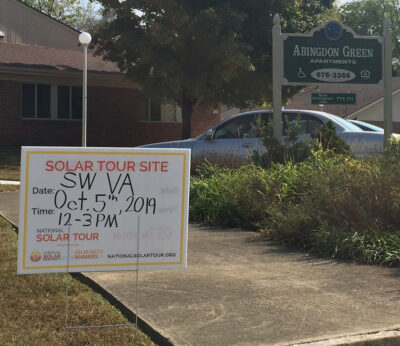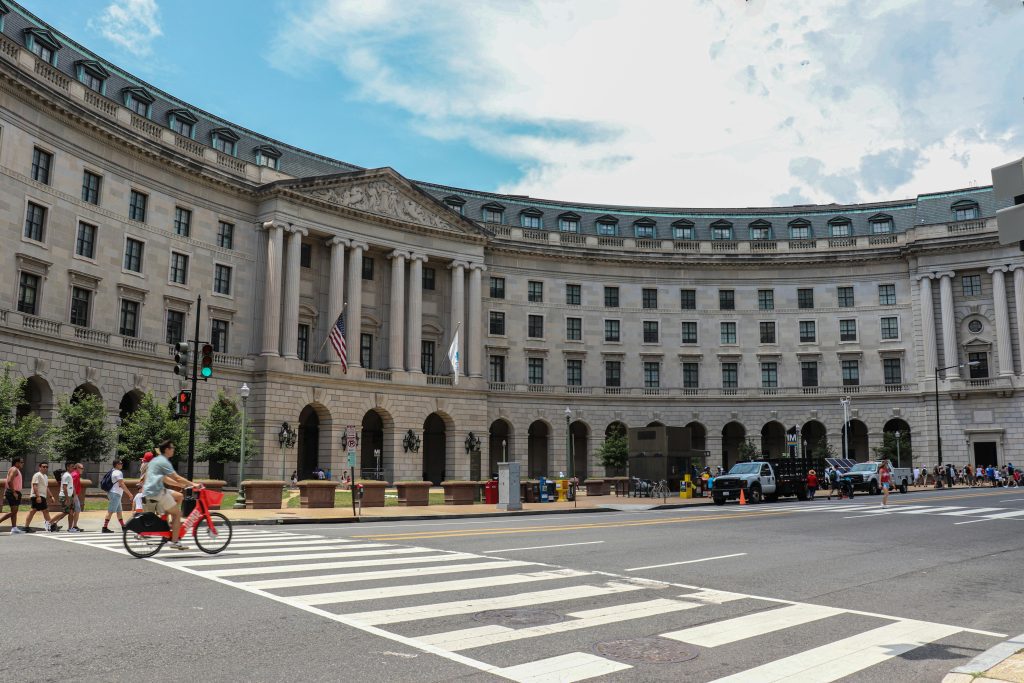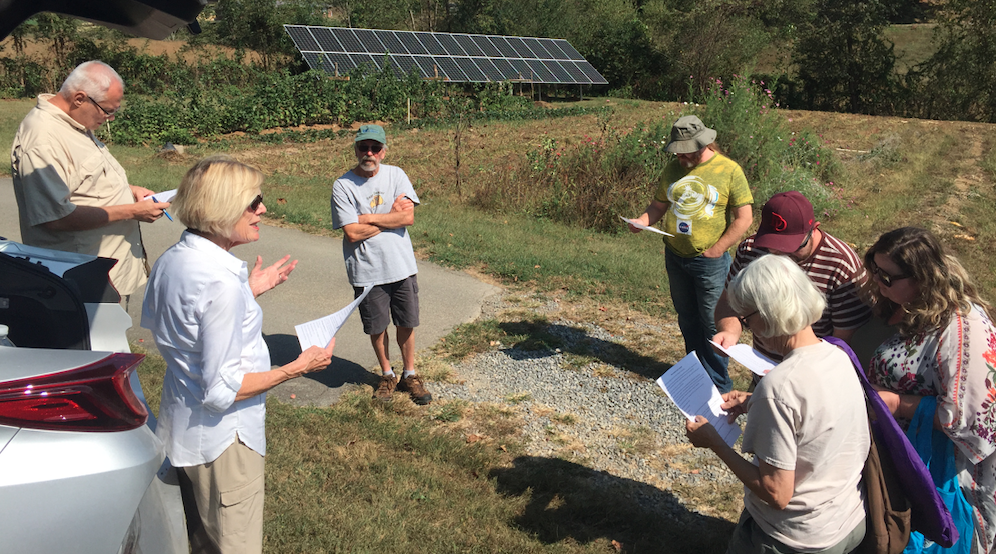
Laurel Flaccavento discusses her family’s solar installation with visitors during the National Solar Tour. Photo provided
The National Solar Tour shows how people are benefitting from producing their own electricity with solar energy in cost-effective ways. The cost to install solar fell by more than 70 percent over the last decade in the United States, according to the Solar Energy Industries Association, an industry trade group.
Presented below are stories from some of the Appalachian stops on the 2019 tour.
Laurel and Anthony Flaccavento
In Abingdon, Va., Laurel and Anthony Flaccavento were motivated to install a solar array on their organic farm because it aligned with their value of preserving the planet and made financial sense. The 9.7-kilowatt ground-mounted system was installed by the company Ecological Energy Systems in 2016.
“I am saving an enormous amount of money every year through generating our own electricity,” says Laurel Flaccavento. She expects the system to recover its cost within 10 years of its installation.
The installation process for the Flaccaventos’ solar system involved sealing the house for energy efficiency and receiving several cost estimates from installers. The family’s other sustainable living habits include driving a fuel-efficient vehicle, using renewable geothermal heat for their house and growing clean food.
Laurel Flaccavento would like to install more solar, but Virginia regulations limit the amount of energy that grid-connected residential systems can produce to the amount used on the previous 12 months of the electric bill. Laurel Flaccavento adds that the cost of battery storage is not yet feasible.
“That rule or law needs to be changed,” she says. “You should be able to generate as much solar as you want.”
Laurel Flaccavento has several recommendations for people considering solar.
“I would say going with somebody local,” says Flaccavento. “It’s good for the local economy for one thing, but it’s also, if anything does happen, you’ve got somebody right there. And, I would get estimates. At least two estimates.”— By Jack Singletary
Kuhre Center for Rural Renewal
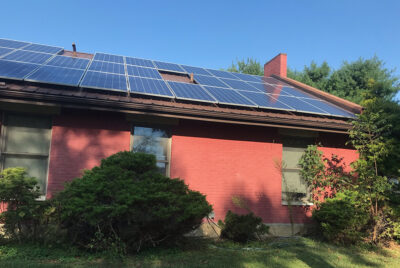
Solar panels now grace the roof of the Kuhre Center for Rural Renewal, a former coal company building in The Plains, Ohio. Photo courtesy of Rural Action
“Rural Action recognizes that solar is a key transition for our region, that as an organization we really want to walk the walk and not simply talk the talk about making that shift to clean energy,” says Sarah Conley-Ballew, program director of sustainable energy solutions.
The organization worked with clean energy project developer New Resource Solutions to allow investors to own the grid-tied system. Then, Rural Action signed a power-purchase agreement, a financial arrangement that allows the organization to purchase the system’s output from the developer at a lower cost than their prior utility bills while paying off the system. This way, the project could benefit from the 30 percent federal tax credit since the owners of the installation pay taxes while the nonprofit is tax exempt.
The system was installed by Third Sun Solar, a company located in Athens, Ohio. — By Jack Singletary
Keenan Phillips

Keenan Phillips stands by the ground-mounted solar panel system that powers his off-grid home. Photo provided
“Batteries can be a hassle, but I really like to tinker and mess with technology and learn stuff so that’s what did it for me,” says Phillips.
When Phillips calculated that the projected cost of his 981-watt solar system over 15 to 20 years was less than the prices offered by his local electric utility, he was happy to make the investment. It also helped that he had the know-how to connect nickel-iron batteries when his set of lead-acid batteries were destroyed in freezing weather.
Next, Phillips would like to replace the propane he uses for cooking with methane from food scraps by connecting an airless anaerobic digester with project designs by open-source platform Solar C³ities.
Phillips was able to reduce energy loss and the size and expense of components in his installation by using several direct current appliances such as a refrigerator that can be connected straight to the batteries with a breaker in-between.
“I would say, only for people who are looking at doing batteries, to at least thoroughly investigate the nickel-iron a.k.a. Edison battery,” reccomends Phillips, touting the battery’s longevity. “I think it’s a pretty amazing type of battery and technology.”
Phillips also offers workshops on solar and DIY building. Visit his website at ksphillipscontract.wixsite.com/website for details. — By Jack Singletary
Lorenzo Rodriguez
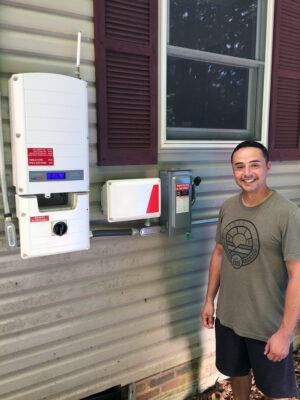
Net metering allows Lorenzo Rodriguez to send excess power from his home solar panels to the grid and to draw power from the grid when needed. Photo by Austin Counts
“For me, because it was more than just a dollar thing, I thought, if I could be breaking even but I am still saving the energy component, [by] being a little bit more green and not using as much [electricity from the grid], then why not?” said Rodriguez.
The installation was in part made possible by several financial incentives including the national 30 percent tax credit, which is scheduled to drop to 26 percent in 2020, 22 percent in 2021 and end in 2022.
Additionally, Sigora Solar offered an installation financing program that included no payments for 12 months, then a 25 percent down payment after Rodriguez received the 30 percent tax credit, followed by monthly payments for 20 years. While 20 years may sound like a long time, Lorenzo says he is still “breaking even.” His monthly electricity bills now come mostly in the form of the financing payments for the solar installation, which, during sunny months, are less than his previous utility bills
Rodriguez also takes advantage of the net metering available with his electric utility, Old Dominion Power, to transfer credits for electricity from months when the system produces more than the house uses, to months, typically in the winter, when the solar installation does not meet all of the energy demands.
While net metering helps folks with solar, in 2019, Old Dominion Power filed a proposal with the Virginia State Corporation Commission to increase the basic service charge for residential customers by $4.13 a month, and raise rates in a way that would increase average household monthly electric bills by $28.93. Both could affect Rodriguez, but ratepayers without solar would see costs rise more. Environmental nonprofit group Appalachian Voices, the publisher of this newspaper, is intervening in the case, which will be heard by the SCC in January 2020.
“I would do [a solar installation] now while you can maximize the tax rebate, because it was very useful. I can’t state that enough. So, why wait?” Lorenzo says, recommending that people “look for a company with financing options.” — By Jack Singletary
People Incorporated

Mark Moormans of People Incorporated tells solar tour attendees about his organization’s work to bring the benefits of solar to low-income residents in Southwest Virginia. Photo by Austin Counts
After a staff member suggested using renewable energy to lower their clients’ cost of living in 2011, the nonprofit launched a solar pilot project at the Clinch View Manor Apartments in Gate City, Va. A year later, People Incorporated received a $1 million renewable energy grant through the American Recovery and Reinvestment Act, which they distributed to several projects.
About half of the grant went toward building geothermal installations for clients in Damascus, Va. Another quarter went to solar energy projects in Abingdon, Va., including building 32 solar hot water heating units at Abingdon Green Apartments in 2012. The apartment complex was featured in the solar energy tour to increase public exposure to solar installments in Washington County, Va.A portion of the grant also funded solar panels at an affordable apartment complex, Dante Crossing Apartments, in Dante, Va. Mark Moormans, People Incorporated’s representative in the Solar Workgroup of Southwest Virginia, explains that the installation cuts the Dante residents’ utility expenses by 50 percent.
People Incorporated planned to install solar panels on affordable residences in Abingdon and Norton, but their progress was stopped by roadblocks from Old Dominion Power and Appalachian Power. These roadblocks are caused by restrictions on meter aggregation, as neither utility would allow for the dispersal of solar electricity from one system to the multiple housing units at each site. People Inc. put both projects on hold and, along with the rest of the Solar Workgroup, is pursuing legislation to remove these barriers and make solar more accessible to low- and moderate-income communities.
Moormans encourages the community to voice their opinion about new solar energy laws to their state delegates during the Virginia legislative session in early 2020.
“Whatever people can do to vocalize their support around changing the policy landscape would make a huge difference,” he says.
If state representatives and legislators hear the public saying that they want renewable energy made more accessible, Moormans believes that the new legislation will have a better chance at passing. — By Rachael Kelley
Spencer Presbyterian Church
Brenda Wilson is one of nine dedicated congregation members at Spencer Presbyterian Church in Spencer, W.Va. Each member is an environmentalist in their own way, so their decision to install solar panels on the church’s roof in 2018 was an easy one.
Wilson takes minutes and keeps records for the church’s decision-making group, and because of her experience and passion for solar energy, she also organized the church’s installation.
Wilson applied for the Restoring Creation Loan, which aids churches in reducing their carbon footprint, through the Presbyterian Church U.S.A.’s Investment and Loan Program. Spencer Presbyterian Church received a $44,000 loan with 2.5 percent interest and a $10,000 grant to put toward their solar energy system. Including the down payment, the total investment came to $60,000.
In summer 2018, Solar Holler installed an 89 panel, 28.48-kilowatt solar array on their roof. Though the system was designed to cover 95 percent of the electricity costs, the church’s designation as a “commercial account” by Monongahela Power Company requires them to pay a minimum fee each month.
“Those things were things we hadn’t anticipated,” Wilson explains. Though they did not expect the extra charge, members of the congregation and community continually voice their support for the church’s decision to go solar.
“They’re all like, ‘Yeah, this was the right thing to do,’” she continues. “It’s gonna help the environment, it’s a model for the community. That’s why we’re doing this. It’s all been really very good, and people have been very positive about it.”
Beyond her work at the church, Wilson and her husband also strive to live sustainably. Sixteen field-mounted solar panels in their yard provide energy to their three-room cabin and newly purchased electric car.
Through the church’s panels and her own dedication to renewable energy, Wilson and her congregation hope to keep solar in the minds of the community. — By Rachael Kelley
Linda Orth

Linda Orth’s garage solar array was made possible in part due to TVA’s Green Power Providers program, which the utility is discontinuing. Photo by Linda Orth
Orth’s interest in installing solar again was inspired by her previous system in Hawaii, which paid itself off in five years, and the advice of a friend. The installation was also practical because of the Tennessee Valley Authority’s Green Power Providers program that Orth’s local power company partnered with to reimburse Orth at a rate of nine cents for every kilowatt-hour generated by the solar installation. This program is slated to end on Dec. 31.
According to Orth, the installation also sparked the interest of her community, and participating in the tour helped her to meet some of her neighbors for the first time.
“We had the sign out, everybody was curious,” says Orth. “They had seen the panels go up on the garage and, you know, nobody on the street had solar, so they were interested.”
Going forward, Orth mentioned that she might add battery storage to her solar installation once batteries become more cost-effective.
“If you’ve got that amount of money just sitting in the bank, why not invest it into something that not only will pay off, but will also be good for our environment,” Orth says to those interested in installing solar. “That would be my advice… Do something with it to help you and somebody else.” — By Jack Singletary
Related Articles
Latest News

Leave a comment
Your email address will not be published. Required fields are marked *


